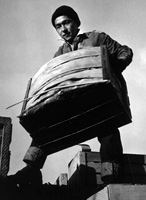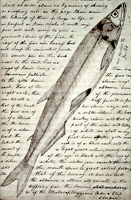Emissaries of Peace
Linda Randulfe, who produces and directs Colonial Williamsburg's Electronic Field Trips, outlines the North Carolina Cherokee nation's negotiations with colonists, including Chief Ostenaco's visit to England.
Linda Randulfe, who produces and directs Colonial Williamsburg's Electronic Field Trips, outlines the North Carolina Cherokee nation's negotiations with colonists, including Chief Ostenaco's visit to England.
Headmistress Ann Wager taught at the Bray School in Williamsburg, VA, from 1760 to 1774, educating enslaved children. Interpreter Antoinette Brennan shares details from Wager's life and describes the school and its operations.
The Engagement at Honey Springs (called the Affair at Elk Creek by the Confederates) was the largest of more than 107 documented hostile encounters in the Indian Territory. The engagement took place on a rainy Friday, July 17, 1863, between the 1st Division, Army of the Frontier, commanded by Maj. Gen. James G. Blunt and the Confederate Indian Brigade led by Brig. Gen. Douglas H. Cooper. Cherokee and Creek regiments fought on both sides. There were approximately 9,000 men involved, including other Native Americans, veteran Texas regiments, and the 1st Kansas Colored Volunteers (the first black regiment in the Union army). The 1,100 acre site has six walking trails with a total of 55 interpretive signs.
The site offers occasional living history events and other educational and recreational programs.

During World War II, the U.S. Government forced more than 100,000 Japanese Americans to leave their homes and businesses, relocating them to internment camps from California to Arkansas. Well-known photographer Ansel Adams documented the lives of Japanese Americans at the Manzanar War Relocation Center in California—from portraits to daily life, including agriculture and leisure.
This site presents 242 original negatives and 209 photographic prints, often displayed together to show Adams's developing and cropping techniques. His 1944 book on Manzanar, Born Free and Equal is also reproduced. Adams donated the collection to the Library of Congress in 1965, writing, "The purpose of my work was to show how these people, suffering under a great injustice . . . had overcome the sense of defeat and dispair [sic] by building for themselves a vital community in an arid (but magnificent) environment."
Professor David Henkin examines the ongoing war between Native American nations and the United States in 1812 and prior to and following 1812. He also considers popular memory of Native American history and failure to integrate it into U.S. history as a whole.

This well-designed site presents the Nebraska edition of the Lewis and Clark journals, edited by Gary E. Moulton. The site provides the complete text of all the journals from the 18031806 expedition, as well as introductions, prefaces, and sources. The material is searchable by keyword and phrase.
There are 29 scholarly essays about the expedition. An image gallery offers 124 images of pages from the journals, 95 images of people and places, and 50 images of plants and animals encountered on the expedition. The maps section includes 12 explanatory maps and nine images of maps from the journals. Additionally, there are 27 audio excerpts of journal readings and eight video interviews with the editor of the project. The website stands as an outstanding resource for researching the history of the Lewis and Clark expedition.
Tukufu Zuberi of PBS's History Detectives introduces the Underground Railroad, the network used to transport slaves to freedom.
William Henry Harrison built Fort Meigs on the Maumee River in 1813 to protect northwest Ohio and Indiana from British invasion. Today's reconstruction is one of the largest log forts in America. British and Canadian troops, assisted by Indians under Tecumseh, besieged the fort twice. The 10-acre log enclosure with 7 blockhouses and 5 emplacements presented a formidable defense. The first assault was in May of 1813 and the second was in July. Both failed and the British retreated after the second. The Museum and Education Center has 3,000 square feet of exhibits and artifacts—including soldiers' letters and diaries, weapons, maps, and uniforms—that describe Fort Meigs's role during the War of 1812.
A second website covering the site can be found here.
The site offers exhibits; tours; educational programs; workshops and classes; and recreational and educational events, including living history events.
Indian Mill, built in 1861, is the nation's first educational museum of milling in its original structure. The restored three-story structure replaces the original one-story building that the U. S. government built in 1820 to reward the loyalty of local Wyandot Indians during the War of 1812. Many exhibits are placed around the original mill machinery. The restored miller's office displays the history of milling from prehistoric times to the present.
The mill offers exhibits and tours.
The Harriet Beecher Stowe House is operated as an historical and cultural site, focusing on Harriet Beecher Stowe, author of Uncle Tom's Cabin. The site also includes a look into the family, friends, and colleagues of the Beecher-Stowe family; Lane Seminary; and the abolitionist, women's rights, and Underground Railroad movements in which these historical figures participated in the 1830s to 1860s, as well as African-American history related to these movements. The house was home to Harriet Beecher Stowe prior to her marriage and to her father, Rev. Lyman Beecher, and his large family, a prolific group of religious leaders, educators, writers, and antislavery and women's rights advocates. The Beecher family includes Harriet's sister, Catherine Beecher, an early female educator and writer who helped found numerous high schools and colleges for women; brother Rev. Henry Ward Beecher, a leader of the women's suffrage movement and considered by some to be the most eloquent minister of his time; General James Beecher, a Civil War general who commanded the first African-American troops in the Union Army recruited from the South; and sister Isabella Beecher Hooker, a women's rights advocate. The Beechers lived in Cincinnati for nearly 20 years, from 1832 to the early 1850s, before returning East.
The house offers exhibits, tours, and occasional recreational and educational programs and events.